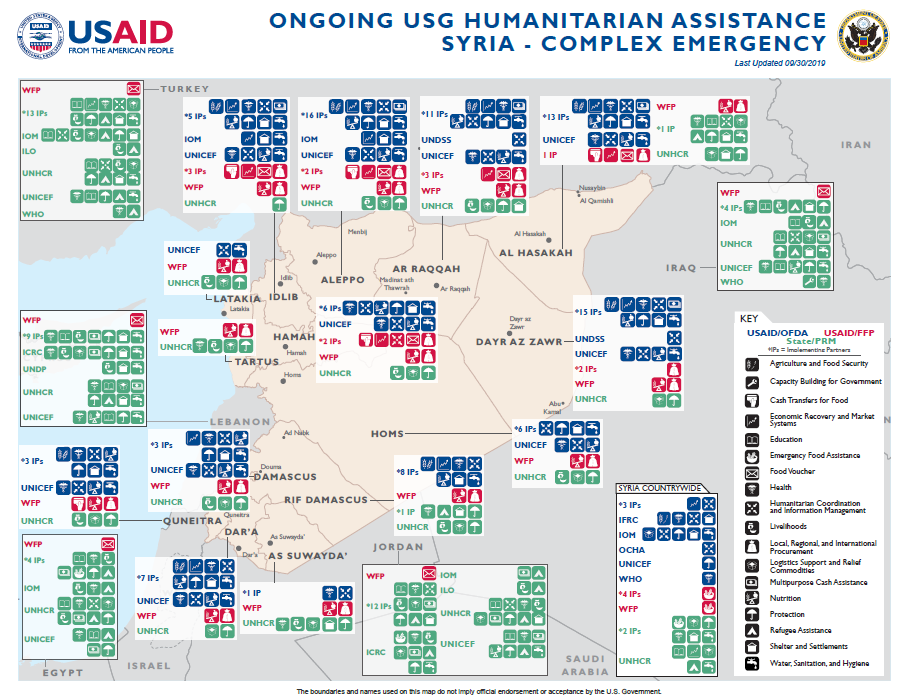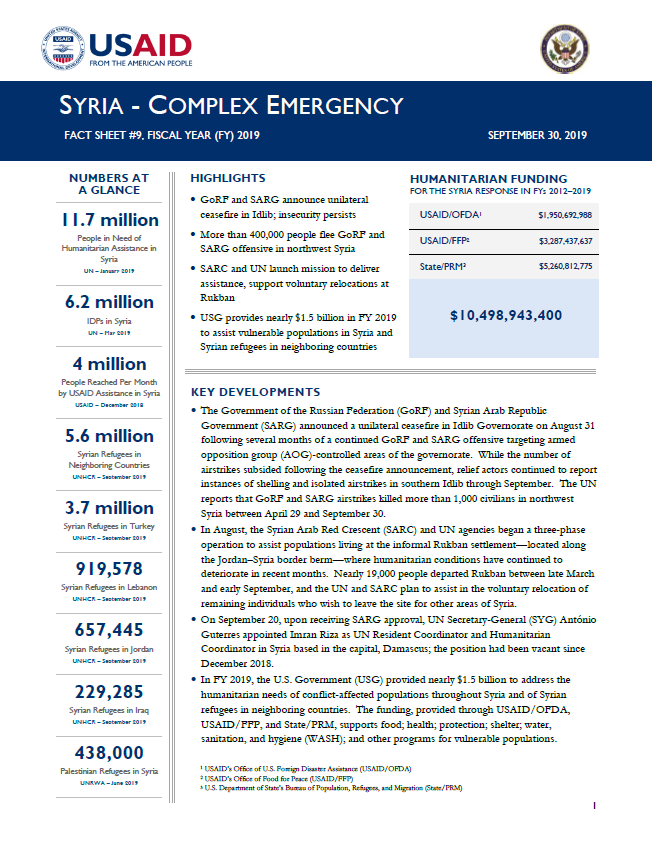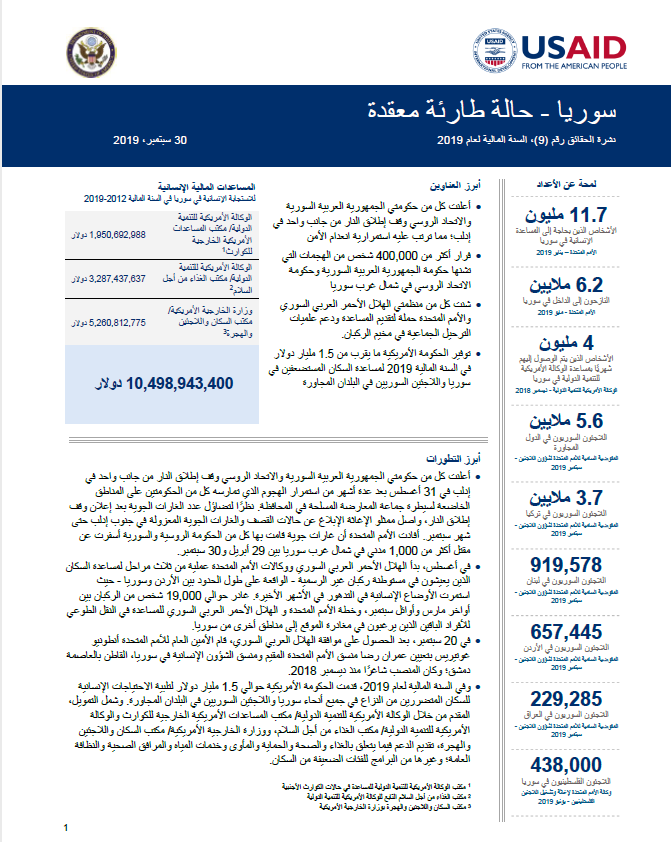- What We Do
- Agriculture and Food Security
- Democracy, Human Rights and Governance
- Economic Growth and Trade
- Education
- Environment and Global Climate Change
- Gender Equality and Women's Empowerment
- Global Health
- Humanitarian Assistance
- Transformation at USAID
- Water and Sanitation
- Working in Crises and Conflict
- U.S. Global Development Lab
Speeches Shim
September 30, 2019
Highlights
GoRF and SARG announce unilateral ceasefire in Idlib; insecurity persists
More than 400,000 people flee GoRF and SARG offensive in northwest Syria
SARC and UN launch mission to deliver assistance, support voluntary relocations at Rukban
USG provides nearly $1.5 billion in FY 2019 to assist vulnerable populations in Syria and Syrian refugees in neighboring countries
Key Developments
The Government of the Russian Federation (GoRF) and Syrian Arab Republic Government (SARG) announced a unilateral ceasefire in Idlib Governorate on August 31 following several months of a continued GoRF and SARG offensive targeting armed opposition group (AOG)-controlled areas of the governorate. While the number of airstrikes subsided following the ceasefire announcement, relief actors continued to report instances of shelling and isolated airstrikes in southern Idlib through September. The UN reports that GoRF and SARG airstrikes killed more than 1,000 civilians in northwest Syria between April 29 and September 30.
In August, the Syrian Arab Red Crescent (SARC) and UN agencies began a three-phase operation to assist populations living at the informal Rukban settlement—located along the Jordan–Syria border berm—where humanitarian conditions have continued to deteriorate in recent months. Nearly 19,000 people departed Rukban between late March and early September, and the UN and SARC plan to assist in the voluntary relocation of remaining individuals who wish to leave the site for other areas of Syria.
On September 20, upon receiving SARG approval, UN Secretary-General (SYG) António Guterres appointed Imran Riza as UN Resident Coordinator and Humanitarian Coordinator in Syria based in the capital, Damascus; the position had been vacant since December 2018.
In FY 2019, the U.S. Government (USG) provided nearly $1.5 billion to address the humanitarian needs of conflict-affected populations throughout Syria and of Syrian refugees in neighboring countries. The funding, provided through USAID/OFDA, USAID/FFP, and State/PRM, supports food; health; protection; shelter; water, sanitation, and hygiene (WASH); and other programs for vulnerable populations.
Syria Complex Emergency - Map #9 FY19 ![]() (pdf - 483k)
(pdf - 483k)
Numbers At A Glance
11.7 million
6.2 million
4 million
5.6 million
3.7 million
919,578
657,445
229,285
438,000
Humanitarian Funding
To Syria Humanitarian Response
FY 2012 - FY 2018
| USAID/OFDA | $1,950,692,988 |
| USAID/FFP | $3,287,437,637 |
| State/PRM | $5,260,812,775 |
| TOTAL | $10,498,943,400 |
Syria Complex Emergency - Fact Sheet #9 FY19 ![]() (pdf - 342k)
(pdf - 342k)
سوريا حالة طارئة معقدة ![]() (pdf - 346k)
(pdf - 346k)
INSECURITY, DISPLACEMENT
Northwestern Syria
Despite the announcement of a GoRF–SARG unilateral ceasefire in Idlib on August 31, airstrikes on AOG-controlled areas in the governorate resumed on September 12, and limited airstrikes and shelling continued in the region as of September 30, international media report. Between May 1 and September 20, GoRF and SARG airstrikes and shelling resulted in the displacement of more than 400,000 people in western Aleppo, northern Hamah, and southern Idlib governorates, including populations displaced multiple times, according to the UN. Additionally, the Office of the UN High Commissioner for Human Rights recorded more than 1,000 deaths, in addition to damage to civilian and humanitarian infrastructure, in northwest Syria since the start of the GoRF–SARG offensive in late April. Prior to the implementation of the ceasefire, airstrikes and shelling killed at least 76 civilians between August 16 and 28 alone, according to the UN.
Northeastern Syria
The UN reports that the population in Al Hasakah Governorate’s Al Hol camp has remained stable in recent months, with approximately 68,600 people sheltering in the camp as of September 25. Relief agencies continue efforts to scale up services for vulnerable populations in Al Hol and meet ongoing humanitarian needs in the camp, including through daily delivery of safe drinking water and provision of food and hygiene kits. However, relief actors continue to highlight the need to improve existing camp infrastructure and availability of services, including health services and WASH infrastructure.
Southern Syria
Populations continued to depart the informal Rukban settlement in recent months. Approximately 19,000 people—more than 45 percent of the existing population as of February 2019—departed the informal Rukban settlement from March 24 to September 3, including approximately 2,200 people who had departed since July 10, according to the UN. The majority of those departing the site transited to collective shelters in Homs Governorate before eventually relocating to areas of origin or other locations.
In August, the SARC and UN launched the first phase of a three-part operation to Rukban, conducting assessments to determine residents’ emergency needs and intentions to depart the settlement. Following the assessments, a joint SARC–UN convoy traveled to Rukban in mid-September, delivering food assistance sufficient for approximately 3,000 households, as well as nutritional supplies for children, and facilitating the voluntary departure of more than 300 individuals. The assistance represented the third delivery to the site since November 2018, with the previous delivery occurring in February. The SARC and UN plan to facilitate the voluntary relocation of remaining Rukban residents in subsequent phases of the operation.
PROTECTION
With USAID/OFDA support, a non-governmental organization (NGO) provided protection-related support to nearly 3,100 children across Dayr az Zawr, Al Hasakah, and Ar Raqqah governorates during August, including recreational activities for conflict-affected children and information sessions for children and adults on protection risks and protection risk mitigation. In Al Hasakah, the NGO also implemented informal education activities in child-friendly spaces to prepare children to return to school.
A USAID/OFDA partner also responded to the protection needs of households in Idlib’s Dana District displaced by conflict in northern Hamah and other areas of southern Idlib. The NGO provided psychosocial support (PSS) sessions for more than 5,000 displaced individuals who had recently arrived in Dana.
With support from State/PRM, the Office of the UN High Commissioner for Refugees (UNHCR) provided protection services, including PSS, to more than 6,300 people across Aleppo and Idlib in August as part of ongoing provision of multi-sector assistance in northwest Syria.
HEALTH
The targeting of health care infrastructure remains a critical threat and continues to hinder access to health care services in northern Syria, with the UN reporting more than 60 attacks on health care facilities and personnel from January to August. From August 28 to 30 alone, GoRF and SARG airstrikes damaged or destroyed seven health care facilities in northwest Syria, according to the UN World Health Organization (WHO). Despite these challenges, USG partners continue to provide critical health services throughout the country. From January to August, USG partner the UN Children’s Fund (UNICEF) supported the vaccination of nearly 3.3 million children ages five years and younger against polio, as well as more than 300,000 children with other routine vaccinations. During the same months, the UN organization also supported health consultations for nearly 1.3 million women and children, trained nearly 1,500 community health volunteers, and reached more than 2.5 million people with health promotion messages.
State/PRM partner UNHCR also continues to support access to health care through distributions of health care supplies and medical devices. During the month of August, the UN agency supported populations across Rif Damascus Governorate with medical supplies, including asthma spray, blood glucose meters, crutches, medical beds, and wheelchairs.
FOOD SECURITY AND NUTRITION
With USAID/FFP support, the UN World Food Program (WFP) provided food assistance to approximately 4.3 million people in Syria in September through regular deliveries within the country and via cross-border assistance. During the month, WFP provided ready-to-eat food rations to approximately 67,600 people recently displaced by conflict, as well as food assistance to more than one million people in northwestern Syria delivered cross-border. In August, WFP reached 4 million people across the country with general food assistance, as well as approximately 110,900 newly displaced people with ready-to-eat food rations. Amid security and access challenges, more than 20 percent of general food assistance distributions in August comprised cross-border operations from Turkey to hard-to-reach areas in western Aleppo and Idlib.
In July, WFP commenced a three-month transitional emergency food assistance program to deliver assistance to populations in newly accessible areas of Dar’a and Quneitra governorates. In coordination with SARC, WFP reached 832,300 people in the governorates by late September.
WASH, SHELTER, AND RELIEF COMMODITIES
Five USAID/OFDA partners continued to conduct WASH activities to meet the needs of populations throughout Syria during August. The partners supported 44,500 people in Aleppo and 32,900 people in Rif Damascus through the rehabilitation of sewage networks. The organizations also conducted debris removal in one community in Dayr az Zawr, supporting approximately 20,000 people. Additionally, the partners improved safe drinking water access for approximately 15,000 people in Homs through borehole rehabilitation and 1,700 people in Hamah through the installation of water tanks.
USG partners UNICEF and WHO report that WASH interventions—including hygiene awareness campaigns, purification tablet and hygiene kit distribution, and water testing—resulted in a significant reduction in diarrheal disease cases in Al Hol camp in recent months. Relief actors reported approximately 60 cases during the week of September 12, compared to more than 1,000 weekly cases at the end of June and nearly 660 weekly cases at the end of July.
As conflict persisted across northwest Syria, State/PRM partner UNHCR reached more than 26,000 households in northwest Syria from January to August through cross-border delivery of tents and other relief commodities, including blankets, hygiene kits, and mattresses, to support recently displaced populations. Overall, organizations coordinating through the Non-Food Items Cluster—led by UNHCR—have supported more than 2.6 million people across Syria with relief items in 2019.
PUBLIC DONATION INFORMATION
The most effective way people can assist relief efforts is by making cash contributions to humanitarian organizations that are conducting relief operations. A list of humanitarian organizations that are accepting cash donations for disaster responses around the world can be found at www.usaid.gov/crisis/syria.
The USG encourages cash donations because they allow aid professionals to procure the exact items needed (often in the affected region); reduce the burden on scarce resources (such as transportation routes, staff time, and warehouse space); can be transferred very quickly and without transportation costs; support the economy of the disaster-stricken region; and ensure culturally, dietary, and environmentally appropriate assistance.




Comment
Make a general inquiry or suggest an improvement.